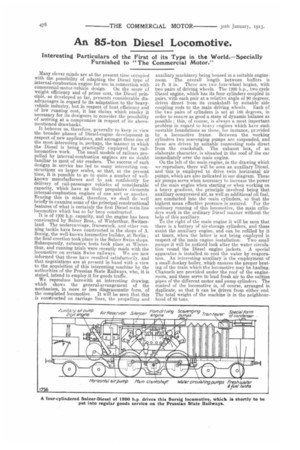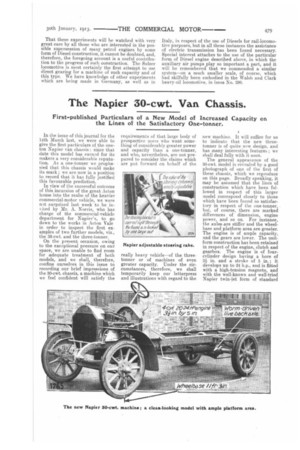An 85-ton Diesel Locomotive.
Page 18

Page 19

If you've noticed an error in this article please click here to report it so we can fix it.
Interesting Particulars of the First of its Type in the World.—Specially Furnished to "The Commercial Motor."
Many clever minds are at the present time occupied with the possibility of adapting the Diesel type of internal-combustion engine for use in connection with commercial-motor-vehicle design. On the score of weight efficiency and of prime cost, the Diesel principle, as developed so far, presents considerable disadvantages in regard to its adaptation to the heavyvehicle industry, but in respect of heat efficiency and of low running cost, it has claims which render it necessary for its designers to consider the possibility of arriving at a compromise in respect of its abovementioned drawbacks.
It behoves us, therefore, generally to keep in view the broader phases of Diesel-engine development in respect of new applications, and amongst these one of the most interesting is perhaps, the manner in which the Diesel is being practically employed for raillocomotive work. The small models of railcars propelled by internal-combustion engines are no doubt familiar to most of our readers. The success of such designs in service has led to many interesting constructions on larger scales, so that, at the present time, it is possible to go to quite a number of wellknown manufacturers and to ask confidently for delivery of rail-passenger vehicles of considerable capacity, which have as their propulsive elements internal-combustion engines of one sort or another.•Bearing this in mind, therefore, we shall do well briefly to examine some of the principal constructional features of what is certainly the first Diesel main-line locomotive which has so far been constructed.
It is of 1200 h.p. capacity, and the engine has been constructed by Sulzer Bros., of Winterthur, Switzerland. The undercarriage, framework, arid other running tackle have been constructed in the shops of A. Borsig, the well-known locomotive builder, at Berlin ; the final erection took place in the Sulzer Swiss shops. Subsequently, extensive tests took place at Winterthur, and running trials were recently made with the locomotive on certain Swiss railways. We are now informed that these have resulted satisfactorily, and that negotiations are at present in hand with a view to the acquisition of this interesting machine by the authorities of the Prussian State Railways, who, it is stated, intend to employ it for goods traffic.
We reproduce herewith an interesting drawing, which shows the general-arrangement of the mechanism, in more or less diagrammatic form, of the completed locomotive. It will be seen that this is constructed on carriage lines, the propelling and auxiliary machinery being housed in a suitable engineroom. The overall length between buffers is 54 ft 9 in There are two four-wheel bogies, with two pairs of driving wheels_ The 1200 h.p., two-cycle Diesel engine, which has its four cylinders coupled in pairs, with each pair at a relative angle of 90 degrees, drives direct from its crankshaft by suitable side coupling rods to the main driving wheels. Bach of the two pairs of cylinders is set at 180 degrees, in order to ensure as good a state of dynamic balance as possible ; this, of course, is always a most important problem in regard to heavy engines which have such unstable foundations as those, for instance, provided by a locomotive frame. Between the working cylinders two scavenging pumps are suspended, and these are driven by suitable connecting rods direct from the crankshaft. The exhaust box, of an elaborate character, is situated in the roof of the car immediately over the main engine. On the left of the main engine, in the drawing which we reproduce, there will be seen an auxiliary Diesel, and this is employed to drive twin horizontal air pumps, which are also indicated in our diagram. These air pumps serve when necessary to increase the power of the main engine when starting or when working on a heavy gradient, the principle involved being that auxiliary compressed air, as well as additional oil fuel, are conducted into the main cylinders, so that the highest mean effective pressure is secured. For the ordinary running of this locomotive, the main cylinders work in the ordinary Diesel manner without the help of this auxiliary. To the right of the main engine it will be seen that there is a battery of air-storage cylinders, and these assist the auxiliary engine, and can be refilled by it at times, when the latter is not being employed in respect of the main engine installation. Two small pumps it will be noticed look after the water circula tion round the Diesel engine jackets. A special apparatus is installed to cool the water by evapora tion. An interesting auxiliary is the employment of a small donkey boiler, which ensures the proper heating of the train which the locomotive may be hauling. Channels are provided under the roof of the engine room, and these serve to lead fresh air to the suttion pipes of the different motor and pump cylinders. The control of the locomotive is, of course, arranged in duplicate, so that it can be driven from either end. The total weight of the machine is in the neighbourhood of 85 tons. That these experiments will be watched with very great care by all those who are interested in the possible supersession of many petrol engines by some form of Diesel construction, it cannot be doubted, and, therefore, the foregoing account is a useful contribution to the progress of such construction. The Sulzer locomotive is most certainly the first attempt to use direct gearing for a machine of such capacity and of this type. We have knowledge of other experiments which are being made in Germany, as well as in Italy, in respect of the use of Diesels for rail-locomotive purposes, but in all these instances the assistance of electric transmission has been found necessary. Special interest attaches to the use of the particular form of Diesel engine described above, in which the auxiliary air pumps play so important a part, and it will be remembered that we commended a similar system—on a much smaller scale, of course, which had skilfully been embodied in the Walsh and Clark heavy-oil locomotive, in issue No. 390.




























